
10 Benepass alternatives in 2025 & how to choose
Explore 10 top Benepass alternatives in 2025 for employee benefits management. Learn how to choose the right platform with our comprehensive comparison guide and selection criteria
In this piece
10 Benepass alternatives in 2025 & how to choose
Switching benefits platforms feels a bit like renovating your kitchen while still trying to cook dinner every night. You know the current setup isn't working, but the thought of ripping everything out and starting over? That's enough to make anyone stick with the status quo just a little longer.
But here's the thing about settling for a benefits platform that's just enough to get you by: it's costing you more than you think. Not just in dollars (though inefficient platforms certainly hurt the budget) but in the hours your HR team spends on workarounds, the benefits your employees never use, and the talent you lose to companies that make their people feel genuinely valued.
If you're reading this, you've probably already decided Benepass isn't the right fit. Maybe it's the limited global coverage, the user experience, or simply that it doesn't scale with your growing needs. Whatever brought you here, you're looking for something better, and you don't have time to test-drive every platform on the market.
In this article, we’re going to talk about 10 strong Benepass alternatives, examining not just their feature lists but how they actually perform in the real world. You'll learn which platforms excel at global benefits administration, which ones your employees will actually want to use, and, perhaps most importantly, which ones will make your job easier instead of harder.
Best alternatives to Benepass
1. Forma
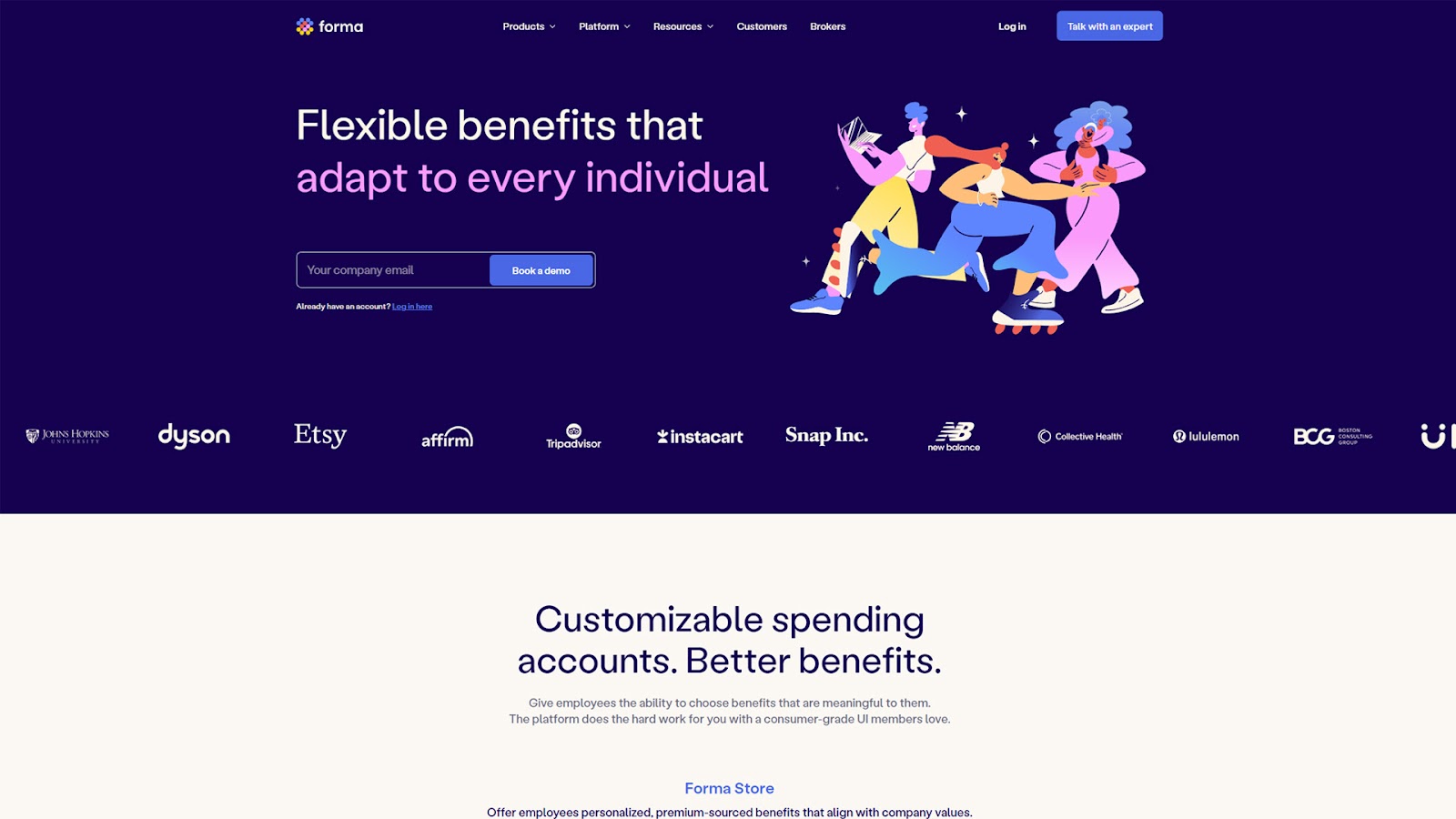
Forma is a flexible benefits platform designed to simplify how companies offer, manage, and scale employee perks across diverse teams. We combine pre-tax and post-tax accounts like LSAs, HSAs, FSAs, and HRAs into a single platform, providing employees the freedom to choose what works best for them.
The platform emphasizes adaptability, offering benefits tailored to individual employee needs and lifestyles, whether it’s wellness, professional development, or family support. For global teams, Forma ensures compliance with local tax and legal requirements in over 100 countries.
Forma aims to reduce administrative complexity for HR teams; our integrations, streamlined workflows, and real-time analytics give you the tools to manage benefits effectively.
Forma vs. Benepass: How do they compare?
While both platforms offer modern approaches to employee benefits, there are notable differences between Forma and Benepass.
- Global support: Forma supports benefits administration in 110+ countries. Benepass offers international features but has fewer localization tools for global teams.
- Customization: Forma provides advanced account configurability, including date-based wallets, pooled funds, and eligibility rules. Benepass is less flexible in tailoring specific program parameters.
- Benefit options: Forma specializes in LSAs but also includes a wider range of benefit types like health reimbursement arrangements (HRAs) and commuter benefits. Benepass focuses more on LSAs and stipends.
- Employee experience: Forma’s platform combines benefits into one interface, with multiple payment options like a branded Visa card, reimbursements, or an integrated vendor marketplace. Benepass relies heavily on card-first spending, which may not fit every employee.
Forma features and benefits
Forma includes several tools and features designed to simplify benefits management for employers while offering flexibility for employees.
Global benefits administration
Forma allows HR teams to manage benefits for employees in over 110 countries while ensuring compliance with local tax and legal requirements.
This guide explains what HR considers when designing a total rewards package, including how platforms like Forma support global compliance.
This includes handling currency adjustments, VAT considerations, and region-specific expenses, which makes it ideal for distributed workforces. With built-in compliance tools, HR teams avoid the risks of tax errors or inconsistent benefit applications in different regions.
Advanced customization
Forma enables employers to customize their benefits programs using flexible configurations like pooled funds or date-based allowances.
Eligibility rules are easy to set with click-not-code tools, allowing you to tailor benefits for specific employee groups or milestones. This level of customization helps HR teams align benefits to company goals while meeting the diverse needs of employees.
Multi-channel payments
Employees can access benefits through Forma in multiple ways: the Forma Store, a branded Visa card, or traditional reimbursements.
The Forma store offers curated perks at discounted rates, while the Visa card provides a seamless payment method with pre-approval for eligible expenses.
Reimbursement options ensure that employees can still access benefits for non-standard or merchant-specific purchases.
Schedule a demo with Forma today to learn more about how we make flexible benefits easier for all parties involved.
2. Rippling
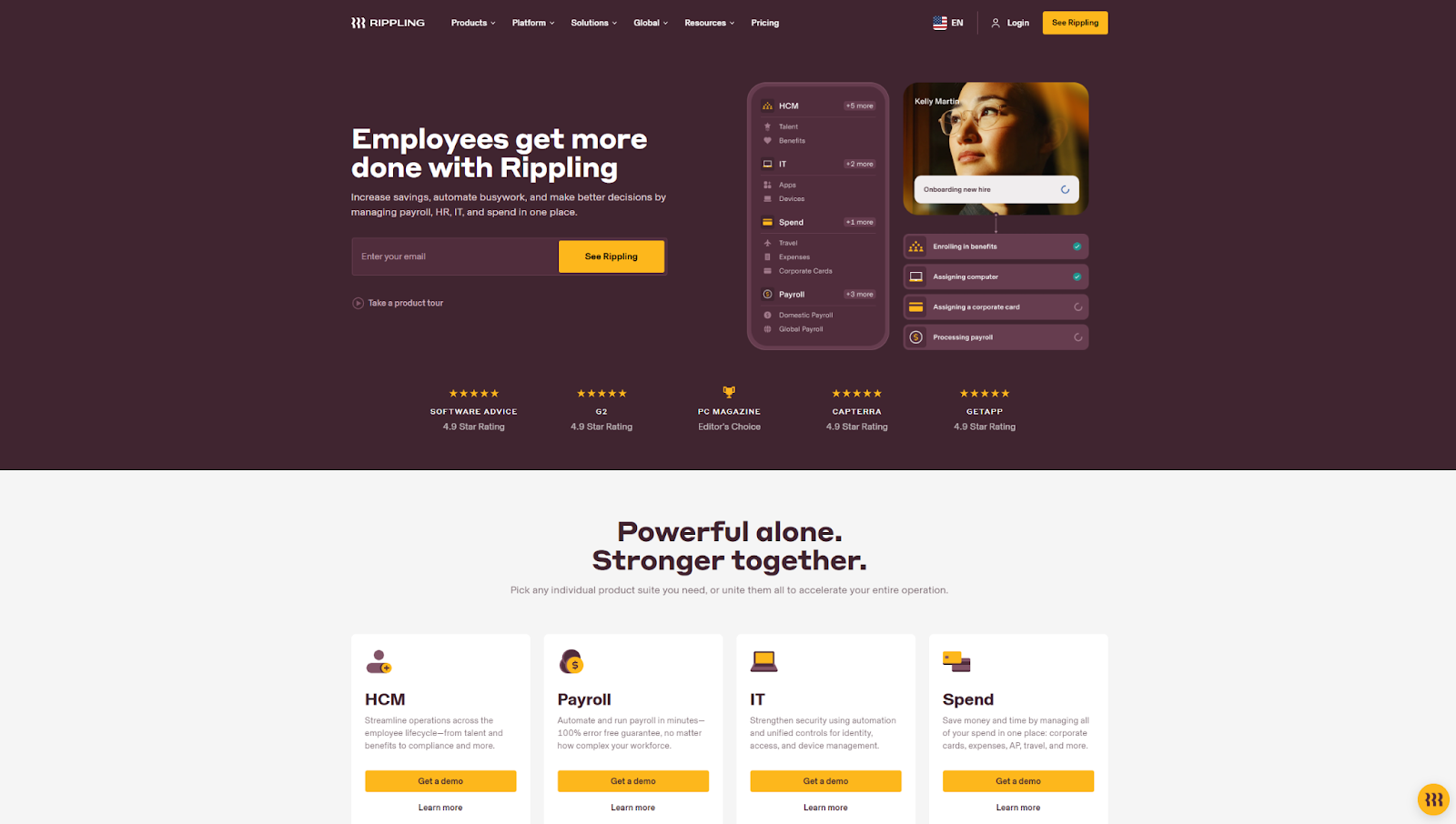
Rippling is a workforce management platform designed to integrate HR, IT, and finance operations into one unified system. It simplifies employee management, automates administrative tasks, and provides tools for payroll, benefits, time tracking, and device management.
Companies looking for a robust solution can try out Rippling for streamlined operations and centralized data management.
Rippling features and benefits
Rippling offers features that span multiple operational areas, enabling organizations to manage their workforce seamlessly.
Employee lifecycle automation
Rippling automates processes across the entire employee lifecycle, from onboarding to offboarding. When onboarding, the platform synchronizes payroll, benefits, software access, and device setup, ensuring employees are operational on day one.
During employment, automated workflows adjust permissions, compensation, or benefits based on role changes like promotions or relocations.
Offboarding triggers tasks like revoking access, retrieving devices, and finalizing payroll, ensuring compliance and data security.
Global payroll integration
Rippling’s payroll module supports international employees and automates complex tax calculations across multiple jurisdictions. Employers can process payroll in multiple currencies while ensuring compliance with local tax laws, deductions, and reporting standards.
Real-time integration with other modules like time tracking and benefits ensures payroll accuracy and reduces manual data entry.
Compliance monitoring
The platform continuously tracks compliance across federal, state, and local regulations to reduce legal risks.
Automated alerts notify HR teams of potential compliance issues, such as expiring certifications or incorrect tax filings. Rippling’s audit trails document every compliance-related action, ensuring readiness for regulatory audits.
3. ADP Workforce Now
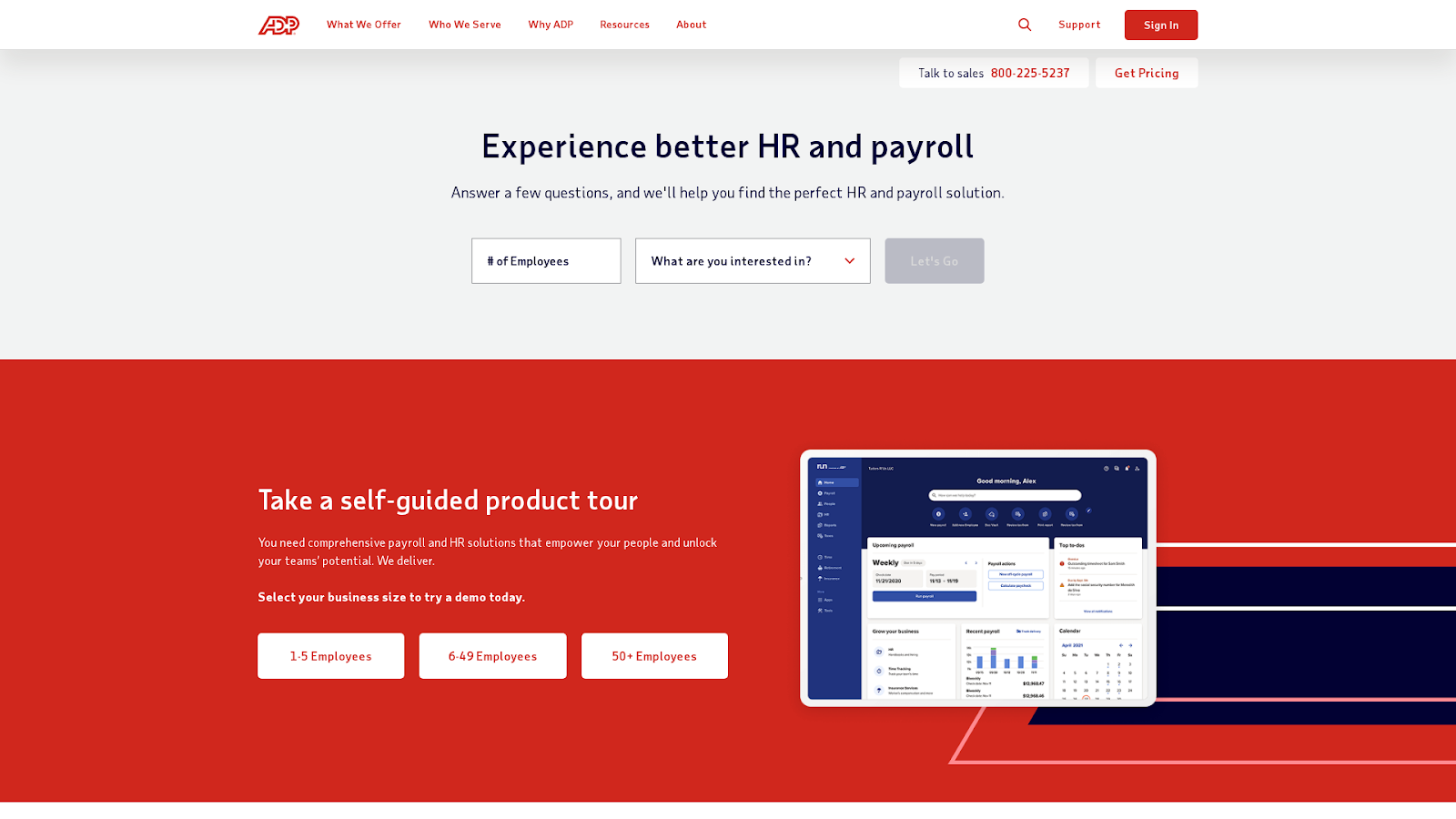
ADP Workforce Now is an all-in-one human capital management (HCM) platform designed for midsized businesses with 50 or more employees. It integrates payroll, HR, benefits, talent management, and compliance tasks into one centralized system.
Companies use ADP Workforce Now to streamline workforce operations and ensure regulatory compliance while gaining access to advanced analytics and automation tools.
ADP Workforce Now features and benefits
This platform offers a variety of features designed to simplify HR administration, improve employee experiences, and enhance workforce planning.
Payroll automation and accuracy
ADP Workforce Now automates payroll processing, reducing time spent on manual calculations and ensuring compliance with federal, state, and local tax regulations. The platform supports multiple payment methods, including direct deposits, paycards, and printed checks, giving employees flexibility in how they receive wages.
Payroll tax filing is handled automatically, with ADP managing year-end reporting and ensuring timely submissions to government agencies.
Benefits administration tools
The platform provides a comprehensive solution for managing employee benefits, including health, dental, vision, and retirement plans. It integrates with over 300 insurance carriers, enabling seamless enrollment updates and reducing manual data entry errors. Employees can access a self-service portal to view their benefits, make changes during open enrollment, or update details following life events.
Talent management suite
ADP Workforce Now includes tools for recruitment, performance management, and workforce development.
Recruitment features allow HR teams to post job openings, manage applications, and onboard new hires efficiently. The performance management tools help businesses set goals, track progress, and provide feedback, fostering employee engagement and development.
4. Gusto
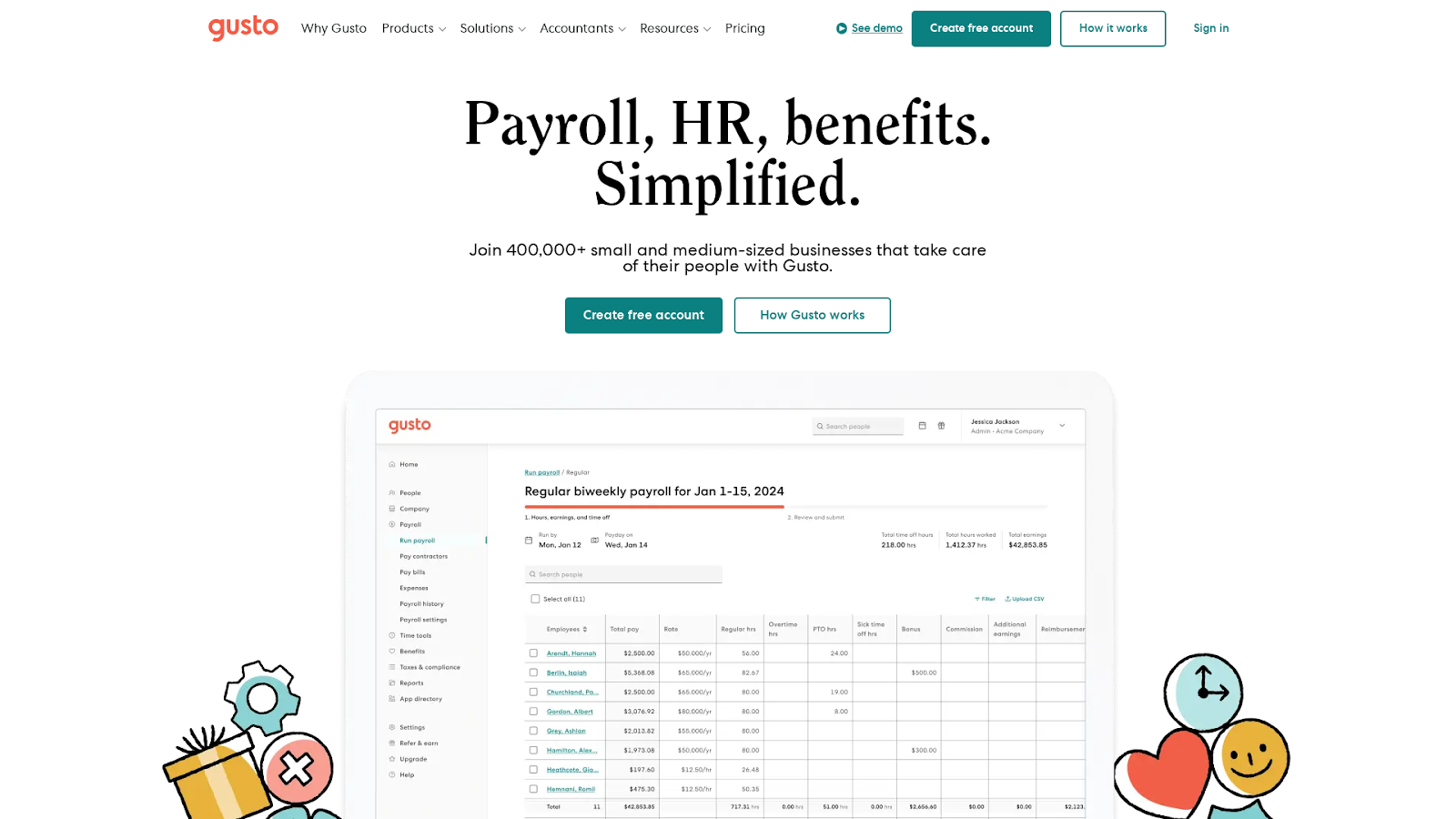
Gusto is an all-in-one workforce management platform that simplifies payroll, benefits, and HR processes for small and medium-sized businesses.
Designed for companies aiming to streamline administrative tasks, Gusto provides tools for payroll automation, benefits administration, employee onboarding, and compliance management.
The platform integrates multiple functionalities into a centralized interface, helping businesses save time, reduce errors, and improve employee satisfaction.
Gusto features and benefits
Gusto offers a variety of features designed to meet the needs of businesses managing payroll, benefits, and human resources. The platform focuses on automation, compliance, and employee experience.
Payroll automation
Gusto’s payroll system handles tax calculations and filings automatically, reducing the risk of errors. Employers can process payroll for employees and contractors across all 50 U.S. states.
The platform supports unlimited payroll runs, enabling businesses to process payments on demand outside of regular schedules. Options like next-day direct deposit ensure timely payments. Customized payroll settings include differential pay rates for specific projects and automatic adjustments for garnishments and deductions.
Benefits management
Gusto offers tools for managing a wide range of benefits, including health insurance, dental, vision, and commuter benefits. The platform integrates with over 3,500 insurance plans. A self-service portal allows employees to review and select benefits during open enrollment or after-life events, reducing the administrative burden on HR teams.
Financial wellness tools, like Gusto Wallet, provide employees with options to save, split paychecks, and access earned wages before payday.
Time tracking and attendance
Built-in time tracking tools allow employees to clock in and out via a mobile app, with geofencing capabilities ensuring accurate location-based logging. The platform integrates time tracking with payroll, automatically calculating overtime, PTO accruals, and compliance with state-specific break requirements. Gusto also provides scheduling tools and supports integration with third-party applications like QuickBooks Time and Deputy for businesses requiring advanced scheduling features.
5. BambooHR
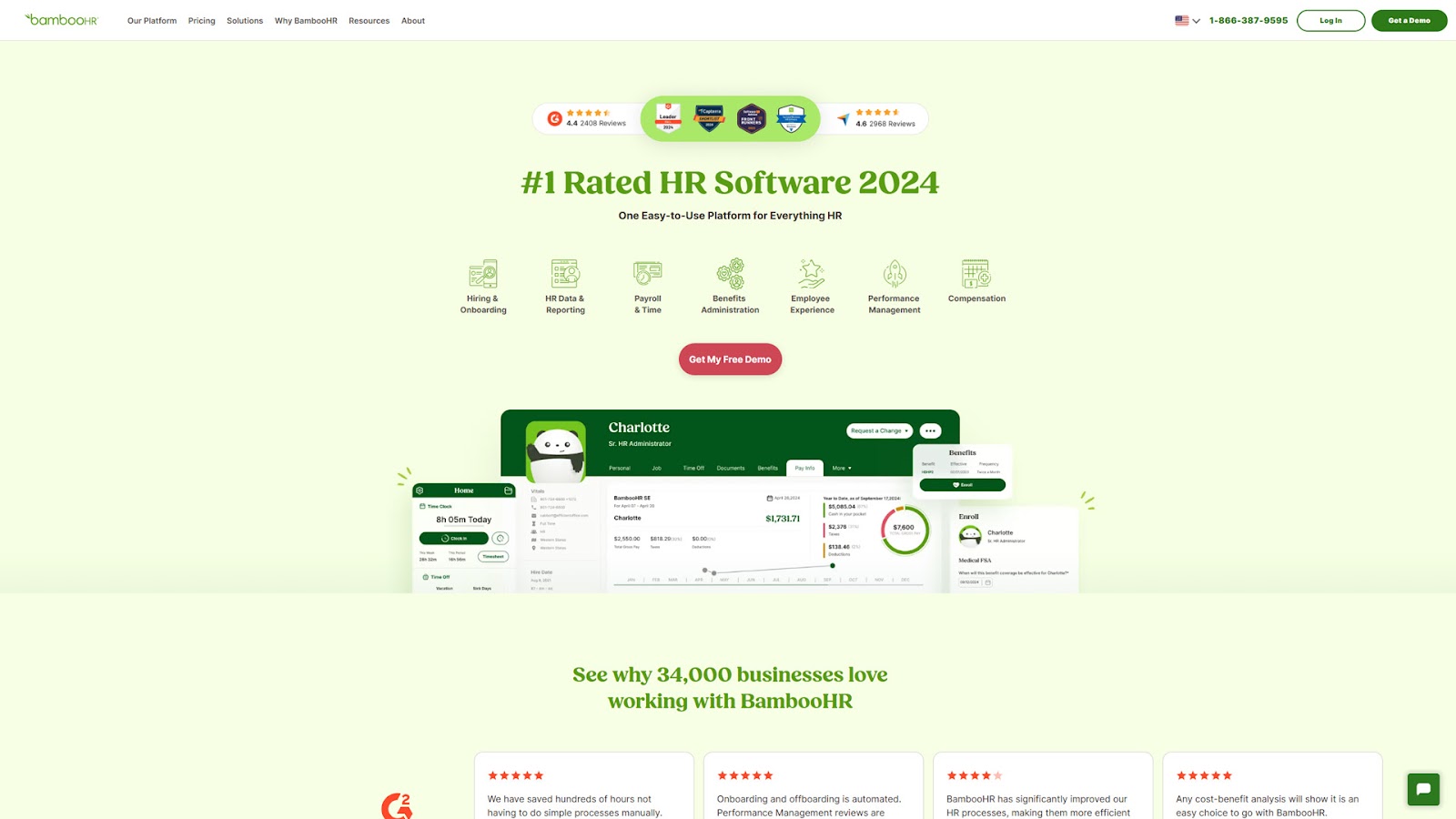
BambooHR is an HR software platform designed to simplify human resources processes for small to medium-sized businesses. It consolidates employee records, payroll, benefits, time tracking, and performance management into a centralized system.
Companies use BambooHR to reduce administrative burdens, improve compliance, and enhance the employee experience through automation and data-driven insights.
BambooHR features and benefits
BambooHR provides a wide range of features to streamline HR management, improve accuracy, and enhance employee engagement.
Centralized employee database
BambooHR’s core feature is its centralized database, which serves as a single source of truth for all employee information. The database stores critical data such as personal details, job history, benefits enrollment, and compensation records, ensuring consistency across all HR functions. Custom fields and templates allow businesses to tailor data collection to their needs, such as tracking certifications, equipment, or compliance documents.
Talent acquisition and onboarding
BambooHR’s applicant tracking system (ATS) simplifies recruitment by automating job postings and candidate management.
The platform includes structured onboarding workflows with digital checklists and e-signatures, ensuring new hires complete tasks like tax forms, direct deposit setup, and policy acknowledgments before their first day. Mobile accessibility allows hiring managers to review applications, provide feedback, and manage onboarding tasks on the go.
Performance management
BambooHR offers tools for continuous performance management, including customizable review cycles tailored to different departments or roles. A 360-degree feedback feature gathers input from peers, managers, and employees themselves, providing a well-rounded view of performance.
The goal-setting functionality tracks individual and team objectives, aligning them with organizational priorities and ensuring accountability.
6. Deel
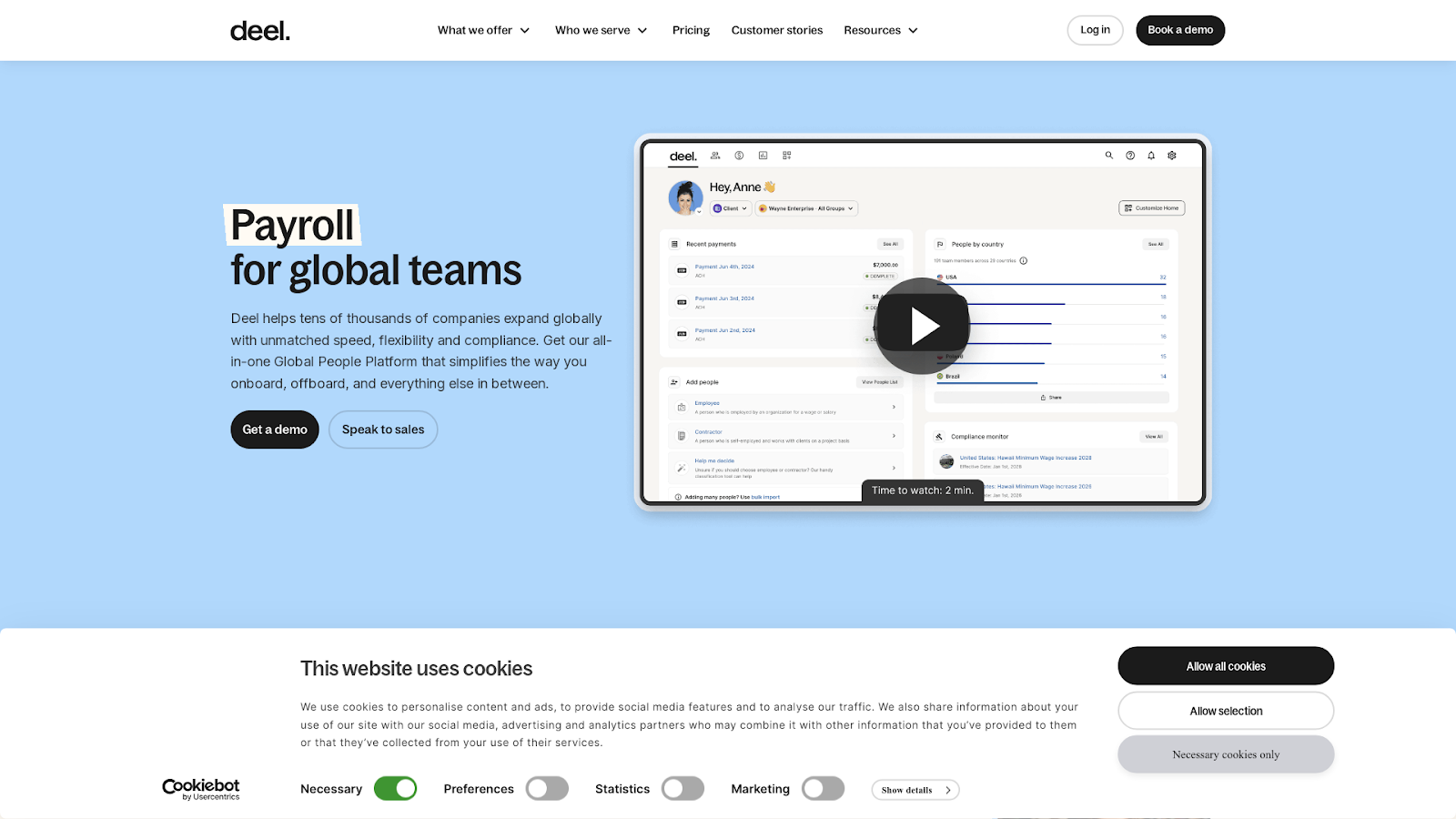
Deel simplifies global workforce management by providing tools for hiring, payroll, and compliance for companies with distributed teams. With its services, businesses can hire employees or contractors in over 150 countries without needing to establish local entities.
The platform centralizes complex administrative processes like tax compliance, payroll processing, and worker classification into one streamlined solution. Deel is designed to support businesses of all sizes, from startups to enterprises, seeking to expand globally.
Deel features and benefits
Deel offers a wide range of features designed to address the challenges of managing a global workforce. Each tool is tailored to improve efficiency, reduce compliance risks, and streamline workforce operations.
Global payroll engine
Deel's payroll system processes payments seamlessly across 150+ countries. The platform supports over 120 currencies and 15 payment methods, including local bank transfers, cryptocurrency, and prepaid cards.
Real-time gross-to-net calculations allow payroll administrators to view detailed cost breakdowns before finalizing payments.
Worker classification compliance
Deel reduces the risk of misclassifying contractors and employees through automated tools. The platform continuously monitors local labor laws and updates contracts to align with legal requirements in each country. An AI-based classification tool ensures an accurate determination of worker status based on jurisdiction-specific guidelines.
Integrated HRIS functionality
Deel includes HRIS features that simplify workforce management and data tracking. The system automates onboarding and offboarding workflows, generating country-specific compliance documents and contracts. Centralized document storage allows HR teams to securely manage contracts, tax forms, and payroll records in one location.
7. GoCo
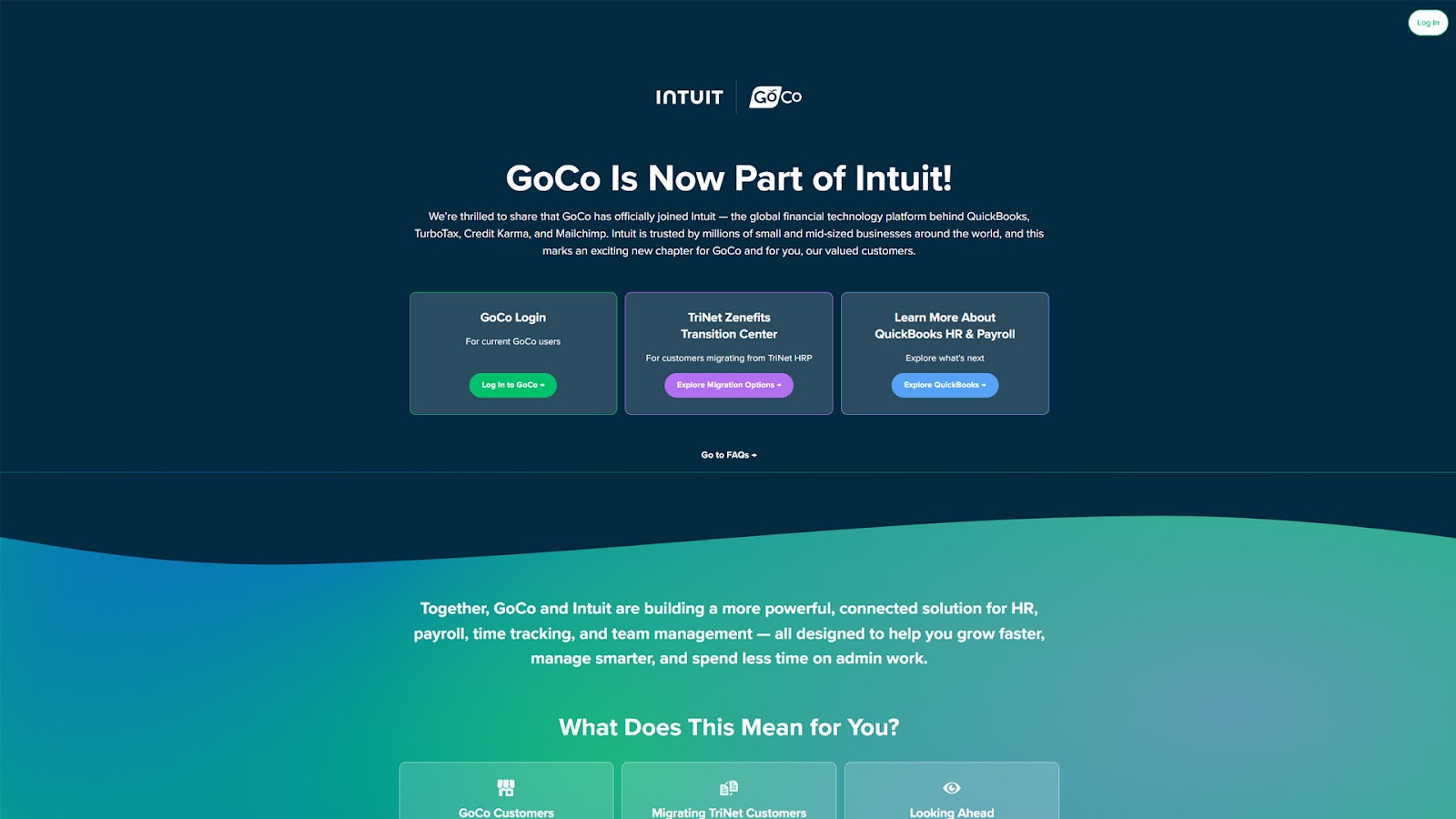
GoCo is a comprehensive HR platform designed to streamline human resources processes for small to mid-sized businesses. It consolidates core HR functions like employee management, benefits administration, payroll integration, and compliance tracking into a single, user-friendly platform.
With a focus on flexibility and automation, GoCo allows businesses to customize workflows, reduce administrative overhead, and improve the employee experience.
GoCo features and benefits
GoCo offers a range of features aimed at simplifying HR operations while maintaining compliance and enhancing productivity.
Centralized employee database
GoCo provides a unified system for storing all employee information, ensuring data consistency and accessibility. Personal details, job history, and compensation records are securely stored in an employee profile, viewable only with role-based permissions.
The platform supports document storage with e-signature capabilities, making it easier for employees to complete forms remotely. HR teams can configure folders and retention policies to meet compliance standards.
With real-time updates, administrators can track changes to employee information, reducing errors and keeping all departments aligned.
Customizable onboarding workflows
GoCo simplifies onboarding by automating tasks like collecting tax forms, setting up direct deposits, and assigning role-specific checklists. New hires can complete paperwork digitally, allowing for a smoother first day.
Integration with IT and payroll systems ensures everything from equipment provisioning to benefits enrollment is completed without delays. For global teams, workflows accommodate regional compliance requirements.
The platform’s automation reduces manual work during onboarding, cutting average processing time by up to 40% for HR teams.
Benefits administration portal
Employees can compare benefits plans through an intuitive self-service portal that highlights cost breakdowns and coverage options. Open enrollment is streamlined, guiding users through qualifying events and required verifications.
The system integrates with over 300 insurance carriers, enabling real-time updates for deductions and eligibility changes. Automated COBRA management ensures compliance when employees leave the organization.
Advanced reporting tools allow HR teams to track benefits utilization, helping businesses make data-driven adjustments to their offerings.
8. Zenefits
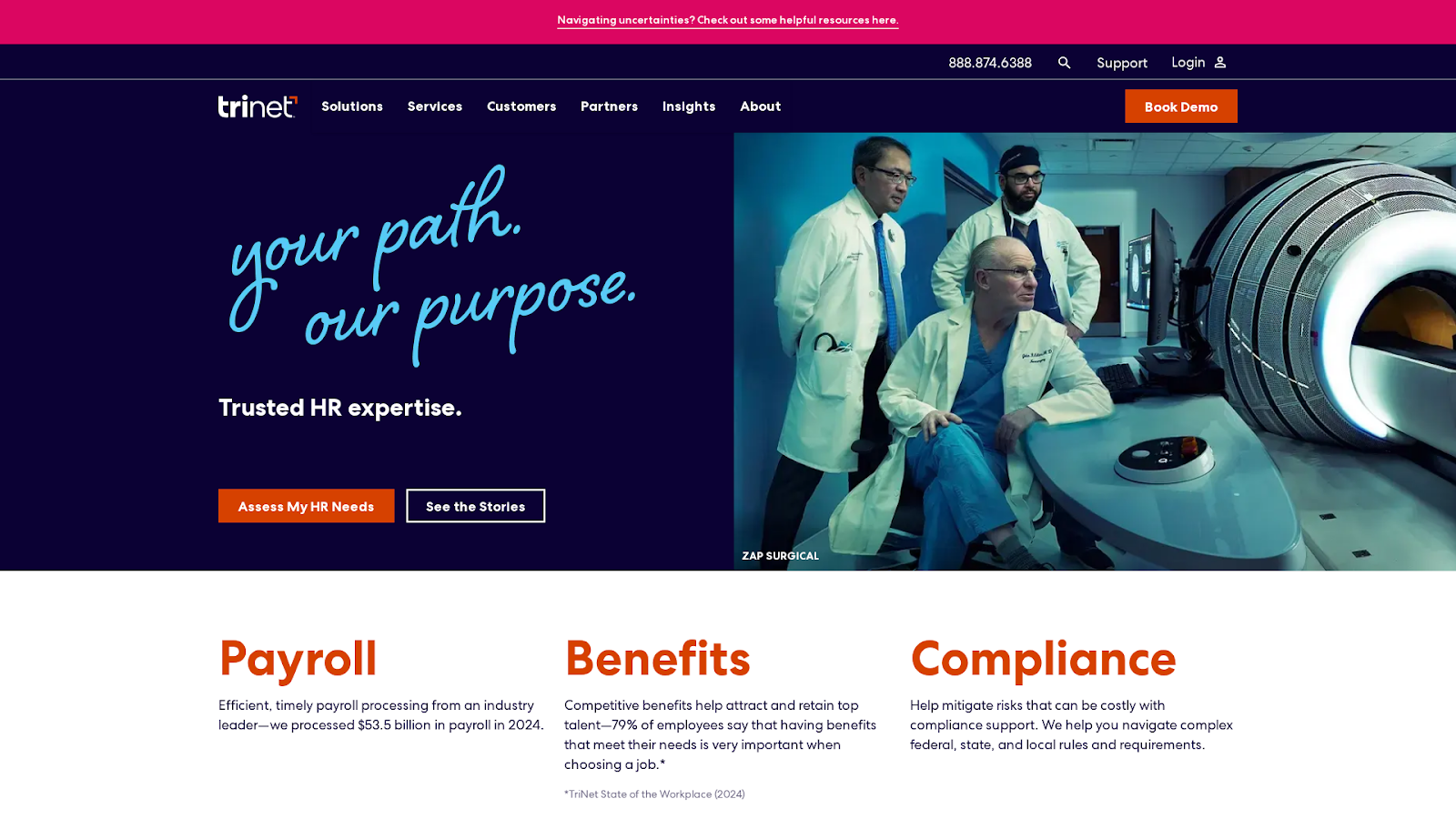
Zenefits is a modern HR platform tailored for small to mid-sized businesses that want to streamline HR, payroll, and benefits administration. Known for its intuitive interface and ease of use, Zenefits is ideal for companies seeking an all-in-one solution with affordable pricing and solid automation.
Zenefits features and benefits
Zenefits brings together core HR functions into one platform, simplifying compliance and operations while delivering a clean employee experience.
Payroll Processing
TriNet offers payroll services designed to streamline timely and accurate compensation for employees. Their system covers all aspects of payroll processing, including payment distribution, tax withholdings, and compliance with federal, state, and local tax regulations.
TriNet states it processed over $53.5 billion in payroll in 2024, indicating a high-capacity infrastructure. The payroll feature integrates with other HR tools and aims to reduce administrative load while maintaining alignment with legal standards.
Benefits Administration
TriNet provides access to a wide range of employee benefits, including health insurance, retirement plans, and other perks. Their benefits administration is structured to help businesses offer packages typically found in larger companies.
This includes managing enrollments, compliance, and integration with payroll systems. According to TriNet, they aim to support employee retention and satisfaction by offering competitive and customizable benefits options, aligning with workforce expectations and market standards.
Risk and Compliance Support
TriNet assists businesses in navigating complex compliance issues related to HR, labor laws, and industry-specific regulations. Their services include support for maintaining up-to-date practices across federal, state, and local levels, as well as guidance in mitigating employment-related risks.
This includes audits, reporting, and document retention strategies. The compliance feature is designed to help businesses reduce exposure to potential penalties or legal challenges tied to mismanagement or oversight in human resources operations.
9. Justworks
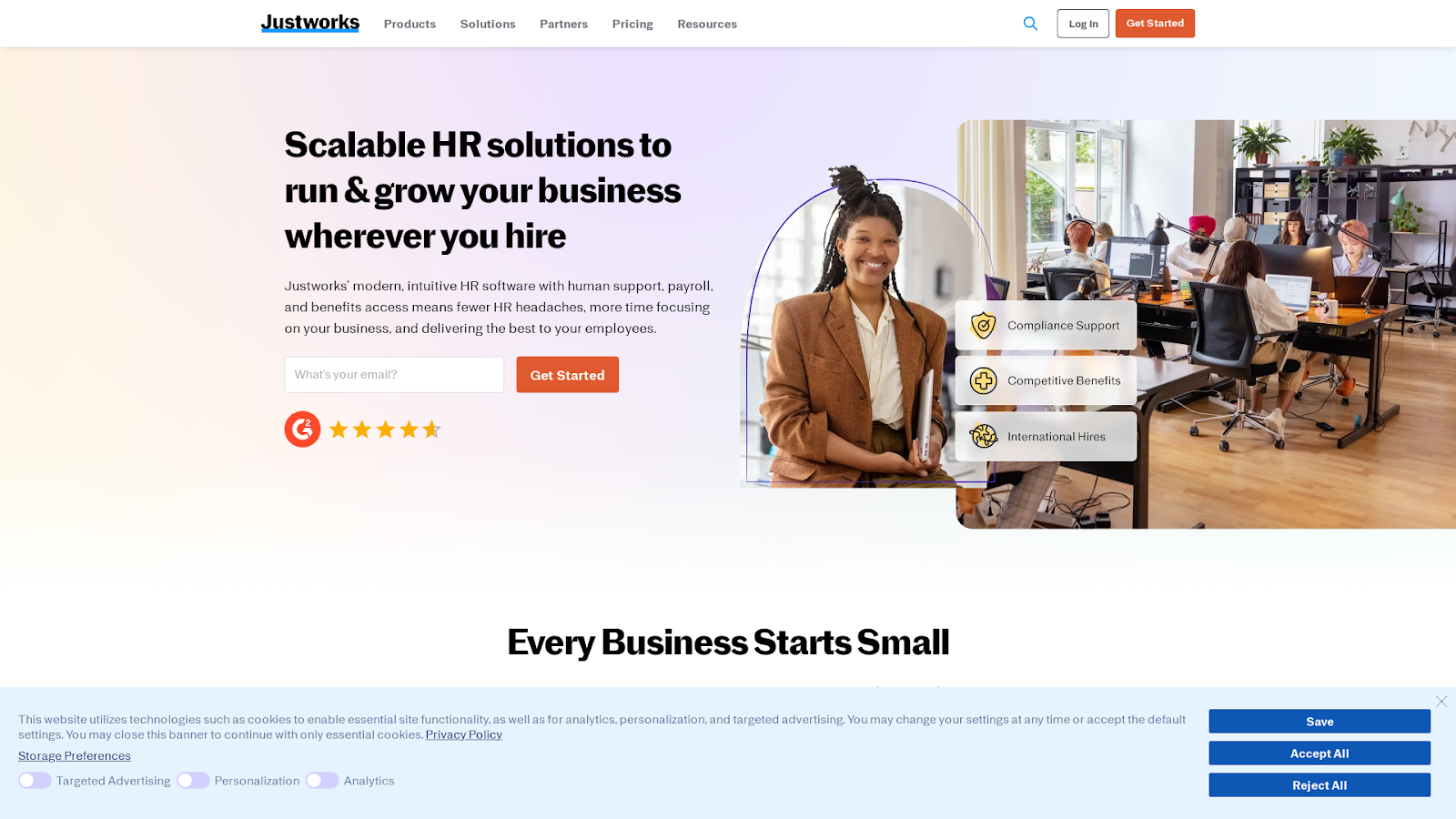
Justworks is a Professional Employer Organization (PEO) that offers bundled payroll, benefits, and compliance services under one roof. It’s ideal for startups and growing businesses that want enterprise-grade benefits without managing HR internally.
Justworks features and benefits
Justworks simplifies back-office operations by acting as the employer of record for tax, benefits, and compliance purposes.
Payroll and Tax Management
Justworks provides payroll processing capabilities that support both salaried and hourly employees, including automatic tax filings, direct deposit, and W-2 generation. In 2023, they processed over $25.6 billion in payroll and handled more than 240,000 W-2s.
The system supports multi-state tax compliance and includes features like off-cycle payments and automated reminders. Businesses can manage payroll tasks through an integrated platform designed to scale with company size and evolving employment needs.
Benefits Access
Justworks offers small businesses access to employee benefits typically available to larger organizations. This includes health, dental, and vision plans, along with wellness perks and 401(k) options. The platform facilitates employee enrollment, benefits tracking, and compliance with ACA regulations.
Benefits administration is managed in sync with payroll, and options vary by location and provider network. Justworks positions this service to help employers provide comprehensive packages without needing to handle vendor relationships directly.
HR Tools and Support
In addition to software, Justworks includes access to live HR support for handling compliance questions and personnel policies. The platform includes tools for onboarding, employee document storage, time tracking, and leave management.
Businesses can also receive support for employment law matters across multiple jurisdictions. Justworks combines digital tools with advisory resources to help companies address HR responsibilities without needing a large internal team.
10. HiBob
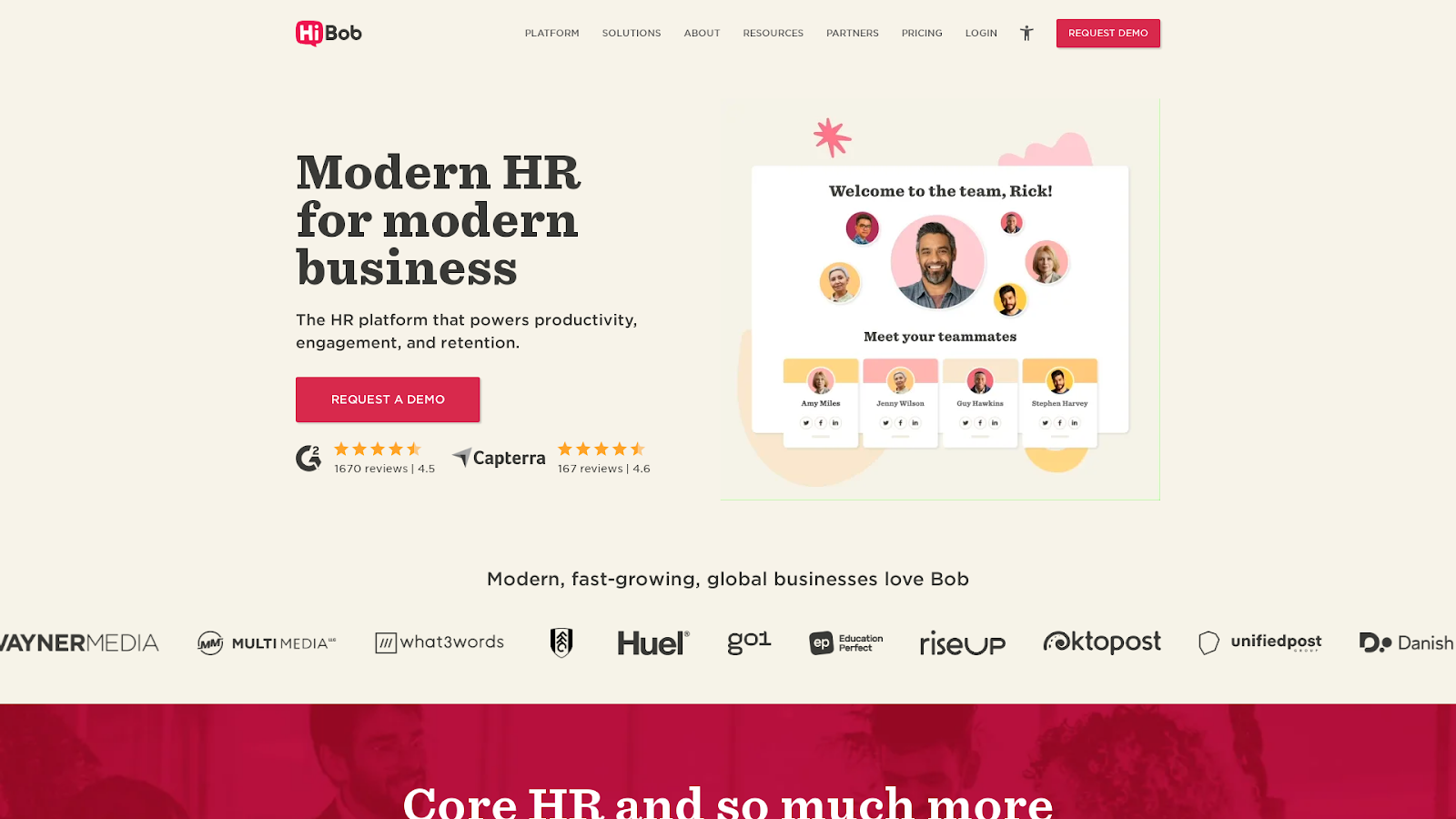
HiBob is a next-gen HRIS designed for global, modern companies that prioritize employee experience and international scalability. With robust benefits tracking, performance tools, and culture features, HiBob helps HR teams engage employees while staying compliant across borders.
HiBob features and benefits
HiBob blends traditional HR functions with people-centric tools that enhance culture, communication, and visibility.
Core HR Platform
HiBob’s platform, Bob, offers centralized tools for managing employee records, workflows, and org structure. It supports global teams with features like customizable policies, multiple time-off types, and location-specific settings.
The system includes onboarding flows, task automation, and integration with external payroll solutions. Bob is designed to serve as the main system of record for HR teams while being accessible to employees, managers, and executives through a user-focused interface.
People Analytics
Bob includes built-in analytics capabilities designed to help HR and leadership track engagement, retention, and workforce trends. Users can generate reports on metrics like headcount, turnover, and diversity.
The platform aggregates data from across the organization, giving visibility into how people-related factors align with business outcomes. These tools are intended to support data-informed decision-making in areas like compensation planning, DEI efforts, and organizational growth.
Employee Experience and Engagement
HiBob includes features designed to foster connection and visibility across distributed teams. These include customizable employee profiles, shoutouts, surveys, and internal communication tools. The system is structured to promote culture and collaboration, with options for sharing milestones, anniversaries, and team updates.
Engagement tools are integrated with core HR data to help track sentiment and interaction levels, especially in hybrid or global work environments.
What to look for in a Benepass alternative?
When comparing Benepass competitors, it helps to focus on platforms that solve the same problems without introducing new ones. Here are five key factors to consider:
1. Customization and flexibility
A major differentiator in the benefits tech space is the ability to adapt to your unique policies and company culture. Seek platforms that support customizable account structures, including pooled or individual funds, detailed eligibility rules by role or geography, and configurable spending windows.
Look for providers that allow for branded experiences and can support multiple benefit types, such as wellness, lifestyle, learning, and commuting, within a unified platform. Flexibility here ensures that your benefits strategy can evolve with your workforce instead of being constrained by your vendor’s limitations.
2. Global support and tax compliance
As remote and distributed teams become more common, global functionality is critical. A strong Benepass competitor should offer international employee support, including multi-currency wallets, localized user interfaces, and region-specific compliance capabilities.
This includes handling tax treatment properly across jurisdictions, both for taxable and pre-tax benefits, and offering guidance or automation around local regulations. Without this, managing a global team could mean maintaining separate systems or creating legal exposure due to compliance oversights.
3. Versatile payment options
The way employees access and use their benefits can dramatically affect engagement. Look for vendors that offer multiple payment modalities, such as virtual or physical benefit cards, expense reimbursements, direct integrations with vendors, or access to curated marketplaces.
Some competitors even allow employees to upload receipts via mobile or chat apps. Offering more than one method of benefit delivery enables a better fit for different benefit categories and user preferences, especially for remote or hybrid workers.
4. Seamless integration and workflow automation
Manual administration is one of the biggest pain points in benefits management. A modern platform should integrate cleanly with your HRIS, payroll system, and identity provider, enabling automated user provisioning, eligibility syncing, and payroll deductions.
Ideally, the platform reduces admin work by auto-approving low-risk transactions, routing exceptions, and generating audit-ready reports. This helps HR and People Ops teams spend less time on manual upkeep and more time on strategic initiatives.
5. Utilization insights and reporting
Understanding how your employees are engaging with their benefits is essential to measuring impact and optimizing your program. The best alternatives to Benepass include built-in dashboards that provide real-time data on benefit usage by type, team, or geography.
Look for platforms that help track utilization trends, flag underused programs, and deliver ROI metrics. Easy access to actionable analytics makes it easier to adjust funding, justify budget allocation, and improve employee satisfaction over time.
What is the best Benepass alternative?
The table below compares leading alternatives based on five core areas: flexibility, global support, ease of use, payment options, and analytics. Scores are based on publicly available data, platform documentation, and user feedback.
Get started with Forma
When you're ready to move beyond the limitations that brought you here, Forma offers the comprehensive solution you've been looking for. We combine the flexibility to customize benefit programs with the global reach to support distributed teams, all while consolidating multiple account types into one intuitive platform. Your employees get the freedom to spend benefits their way, and your HR team gets the tools to manage everything efficiently.
Making the switch doesn't have to be overwhelming. Our experienced onboarding team works alongside you to ensure a smooth transition, and our ongoing support keeps your program running seamlessly. Whether you're managing a growing startup or an established enterprise, Forma scales with your needs and adapts to your evolving benefit strategy.
Ready to see how Forma can work for your organization? <span class="text-style-link text-color-blue" fs-mirrorclick-element="trigger" role="button">Schedule a demo</span> to explore how our platform addresses your specific challenges and goals.
*This document is for informational purposes. Forma is not engaged in the practice of law. Nothing contained herein is intended as tax or legal advice nor to replace tax or legal advice from counsel. If you need tax or legal advice, please consult with counsel or a certified tax professional.














